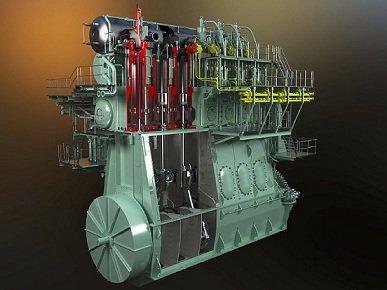Cleaner, natural gas engines for ships

Related topics
Innovation Transport Smart, green and integrated transport Germany Sweden Switzerlanddate: 26/09/2014
Project: High Pressure Electronically controlled ...
acronym: HELIOS
See also: CORDIS
Contact: Contact
Researchers in the EU-funded HELIOS project developed a workable alternative injection system and other related technologies for using liquid natural gas (LNG) to fuel large two-stroke ship engines.
This LNG-fuel control system is the first in the world for two-stroke heavy marine diesel engines, and has generated commercial orders from shippers, says project coordinator, Lars Ryberg Juliussen, a senior manager at MAN Diesel & Turbo in Copenhagen.
MAN Diesel & Turbo has already launched the system on the ship market as an option for new ships and for existing ship engines. Orders have already been placed from companies in the EU, Japan and the US for 20 such dual-fuel engines, with options on 50 more in the offing, he adds. These engines will be built under the MAN licence system in EU, Korea, Japan or China.
The orders include engines on 43 new vessels, of which 1 container vessel will be built in Croatia. Two of the engines will be retrofitted on a LNG tanker in Qatar. The retrofitting job will take about four weeks with a supervising team of eight people from MAN. All components of the “retrofit kit” will be manufactured in Europe.
Cutting sulphur pollutants
The new engines are cleaner burning than traditional two-stroke ship engines running on heavy fuel-oil or diesel, and will help ship operators meet the EU's tighter emission rules on marine sulphur pollutants. The rules come into effect from 2015.
These LNG-fuelled engines will also meet the even stricter regulations entering into force for the North Sea, the Baltic and the Channel, which are being designated "sulphur-emission control areas" with a limit on sulphur in fuel of just 0.1%.
Natural gas is a cleaner fuel than diesel and is free of sulphur dioxide. Sulphur is a major cause of acid rain, and as an air-borne pollutant contributes to a host of human health problems.
An engine fitted with what is known as M-type, electronically controlled, gas injection (ME-GI) technology also cuts nitric oxide and nitrogen dioxide emissions by 24% compared to a similar engine using only diesel or heavy fuel oil, according to tests carried out within the project. Emissions of carbon dioxide (CO2), a major greenhouse gas, dropped by 23%.
Engines the size of a four-storey building
“We are not talking of a 1960s two-stroke motorcycle engine here,” says Juliussen. “This could be a 14-cylinder diesel engine that is 28 metres long, 13 metres high and weighs over 2 000 tonnes. It is the size of a four-storey building.”
While natural gas has been used as a fuel for four-stroke marine engines, to date a control system suitable for the low-rpm (revolutions per minute), two-stroke diesel engines that power 95% of vessels over 5 000 tonnes has not been available. Such engines typically run at around 100 rpm, often turning a single large propeller via direct drive.
The HELIOS researchers developed a new high-pressure gas-injection system for these large marine two-stroke engines. The engines are dual-fuel, running on either LNG or fuel oil. Electronic control-systems drive separate injectors for each fuel type.
The project also created a testing infrastructure for a diesel-gas engine which will be used in the coming years for further tests on gas supply technologies. Other engine components were also developed through the project, including:
- new piston rings for high temperature gas combustion;
- new gas injectors;
- new valves for high temperature gas combustion;
- new optic measurement tools (laser) for monitoring running engines.
Some of the new equipment was developed by universities (sensors) and SMEs (new injectors).
First on the market
Juliussen sees demand for the new engine as likely to build while fuel prices rise and emission controls become ever stricter.
“Our gas-burning engines tend to be more fuel-efficient than fuel-oil because of the higher calorific value of gas as a fuel,” he says. “As the attractions of running on gas become clearer, more and more ports are being fitted with LNG refuelling facilities to meet demand.”
The ME-GI solution will also provide the basis for a new generation of ship engines powered by natural gas.
Some continuation of the research done through HELIOS might be included in the follow up to the Hercules C project. A project proposal is being prepared by MAN and Finland’s Wärtsilä.
